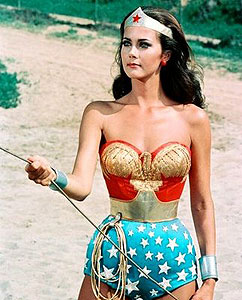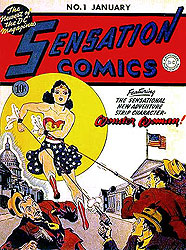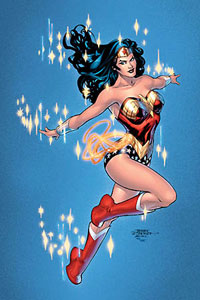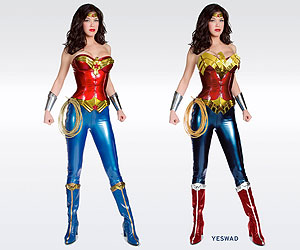Those Boots Aren’t Made For Walking: Wonder Woman Reimagined
Published on March 30th, 2011 in: Back Off Man I'm A Feminist, Comics, Feminism, Issues, TV |By AJ Wood

Lynda Carter as Wonder Woman
I remember little of my childhood, especially anything before age eight or nine, but one memory I do have from age four or five was Wonder Woman. Stripped down to my red and blue briefs and a red T-shirt tucked into them, with a lasso of kite string at my side, I felt wise as Athena, fast as Hermes, and stronger than Hercules. I had to imagine the boots, bracelets, and tiara, but the costume was close enough.
Adventures always began with the iconic twirl and my best imitation of the starburst sound Lynda Carter made on TV when she transformed. There was never any real goal to the adventures, however, unlike on TV: I would just run as though I was after something, then make a mighty leap from the springy bed (much to my mother’s annoyance), and then stop to fling my wrists at imagined bullets, doing spot-on ricochet sounds as the bullets were easily deflected by my bracelets of pure Feminum. The adventure usually ended with me—winded, but a hero(ine) all the same—wrapping my magic lasso around something (sibling, cat, chair, whatever was handy) and commanding it to tell me the truth. Mission Accomplished! Repeat until exhausted, bored, or time for dinner.
But eventually you grow up and get a little cynical about the whole thing: Those boots are really impractical for heroics; you run in a bustier like that and you’re gonna fall out of it; and most of all, boys get funny looks when they pretend to be Wonder Woman. Now, with a new version of the series coming out, I have high hopes it will be able to capture my imagination all over again. But somehow, I just plain fear they’re going to get it all wrong.

Wonder Woman’s first cover
Sensation Comics #1 (January 1942)
The 1970s Lynda Carter Wonder Woman was based on creator Charles Moulton’s original vision. The remote island of Paradise Island is home to a long-lived, peaceful tribe of women: the Amazons. They had escaped to this island to get away from the war-mongering men and created a serene utopia where—free of men’s oppression—they could grow and flourish, both mentally and physically. Thus they have lived for thousands of years until WWII fighter pilot Steve Trevor lands on the island, having been ejected from his crashing plane.
The Amazonians nurse Steve back to health. Then, there is the tricky question of how to get Steve back to America, “the last citadel of democracy.” A contest is held among the Amazonians to see who is the most physically fit to fly Steve back to America.
The Amazonian Queen’s plucky daughter Diana has to compete in disguise as her mother has banned her from the contest. Of course, Diana wins every event and once her identity is revealed, the Queen reluctantly lets Diana fly Steve via invisible plane back to America.
And so Diana does; when she gets so wrapped up in the American WWII fight against the Nazis, she decides to stay and help the people of “Patriarch’s World” further the cause of democracy and peace. And thus, Wonder Woman is born in Washington, DC, taking the identity of “Diana Prince,” a Petty Officer in the Navy who just happened to be assigned to work closely with Steve Trevor.
The TV series remained in WWII in the first season, and then was updated to the present day for the second and third, with a back story about Steve Trevor being the WWII Steve Trevor’s descendant, and other such time-warp foolery. Now in the 1970s, Diana assists a government organization in stopping crime.
Except for a few trivialities (like the assumption of the Diana Prince identity, bracelets of Feminium instead of Amazonium, Diana transforming into Wonder Woman by spinning around, Steve Trevor changing from blond to brown hair), this series followed the original comic book quite closely, even after updating it to present-day America.
This was essentially the Wonder Woman we knew for decades: Amazonian princess out to fight evil and injustice. In the late 1980s, however, DC Comics rebooted most of their characters, giving them new, fuller creation stories, and Wonder Woman was among those affected.

Wonder Woman by Terry Dodson
Wonder Woman vol. 3, #5 (May, 2007)
Copyright © 2007 DC Comics, Inc.
In this new era, Wonder Woman was less the product of a good Paradise Island upbringing, and more a demigod, blessed with powers from Gods on Mount Olympus. Now, abilities were gifts from the gods, including Demeter, Aphrodite, Athena, Artemis, Hestia, and Hermes. That is to say, even among fellow Amazonians, Diana was remarkably strong, fast, wise, and in possession of all other types of godlike traits. With such gifts, Diana has superhuman strength and speed, and can even fly thanks to Hermes’ sandals.
In another change from the original story, the Amazons hold a contest not to see who will take a crash-landed pilot back to America, but rather who will play ambassador in Patriarch’s World to the god Ares, who has declared war on humanity. In much the same way as before, however, Diana wins and is the chosen one.
This new Wonder Woman is nearly part-god (at one point of “rebirth” actually becoming a deity on Mount Olympus) and battles strange, alien monsters alongside other Amazonians who have crossed over to Patriarch’s World, as well as other comic book heroes, like Superman, Batman, and Aquaman. This Wonder Woman’s creation and mission has little in common with Charles Moulton’s original idea.
With a new TV series—also based on the comic book—on the horizon, I can’t help but worry about which way it will turn: classic or new-fangled. But perhaps that’s too binary a choice as really, it may contain elements of both versions of the comic strip Wonder Woman, as well as the 1970s TV series, which I prefer. Here’s how I am hoping it turns out.
The Twirl: Exactly how Diana Prince transformed into Wonder Woman was never really explored in the comics; it just happened. When making the series in the ’70s, they decided that a spinning Diana would gradually morph into Wonder Woman (according to DVD commentary, the spinning was Lynda Carter’s idea). In current comics, they’ve actually kept the spin-change. This would be a non-Moulton addition I would like to see.
Supporting Characters: Steve Trevor and Etta Candy were to Wonder Woman what Lois Lane and Jimmy Olsen were to Superman. I hope they find a way for these characters to exist in roughly the same sort of relationship to Diana as the original. I don’t think it will be WWII America, nor set in the Navy, but I think the idea of these characters is important to the full story of Wonder Woman.
Nemeses: Speaking of WWII, I don’t expect the new Wonder Woman to be battling Nazis, but I also don’t want her battling Ares or some other mythological figure, or even worse, an alien from some far away planet. It seems clear to me that modern-day Nazis could well be terrorists or other violent extremists. Bankers, even. I just hope they keep it human, and that they have Wonder Woman upholding peace and democracy, and not sliding into random extraterrestrial ass-kicking.
Costume: This could use some updating. I don’t mind the bustier with briefs look per se, but in this day and age where even Olympic swimmers have opted for something more modest than briefs (not that I’m endorsing such a move, I may add), I think Wonder Woman would as well. I’m thinking of something like a suit that Catwoman would wear, more like the wetsuit or motorcycle uniform introduced in the ’70s TV series. Oh, and no heels on the boots, please. Also, can we call the “Girdle of Venus” which keeps Diana in touch with her Paradise Island strength something other than a girdle? The idea that it’s a girdle seems far too misogynistic to me. Please, let’s just call it a belt and be done with it. If you’re going to put her in a girdle, you may as well say she’s wearing “Hera’s Lacy Power Panties.”
Origin: This worries me perhaps most of all: Will Diana be a superhuman Amazonian with god-given powers above and beyond her peers, or will she simply be an Amazonian who is powerful as-is? To me, the real appeal of Wonder Woman is that she is basically “just” a woman, not benefiting from alien birth, or technology, or even a radioactive spider bite. Having grown up on Paradise Island, Diana was free of the oppressions that living in a male-dominated world would have imposed on her. Free of such bonds, she can leap higher, run faster, be stronger, be smarter, than any other person, man or woman.
While she was introduced so many years ago as a female role model, I think today Wonder Woman can transcend her gender and serve as a human role model. Yes, she originally overcame the “patriarchs” to be the best human woman one could be, but I think in this day and age, she can be more of a role model for all humanity. Liberated from any sort of oppression, social expectations, or rules, I would like to think any person could be as fast as Hermes, strong as Hercules, and wise as Athena. To draw such strength from who I am, how I am, what I am . . . that’s reason enough to want to strip down to my briefs, get some kite string, and super-high-jump off the bed in pursuit of any evil which—real or imagined—comes my way.
Since this article was written, the first images of the revamped Wonder Woman TV show—starring Adrienne Palicki—have made their way onto the web, to be met by much dismay from the fans. Our friend Matt Dawsey, a graphic artist, has designed a far superior look for Wonder Woman, which you can see below. Hopefully, his pleas to Ms. Palicki via Twitter will not fall on deaf ears, erm, eyes.

Time limit is exhausted. Please reload the CAPTCHA.